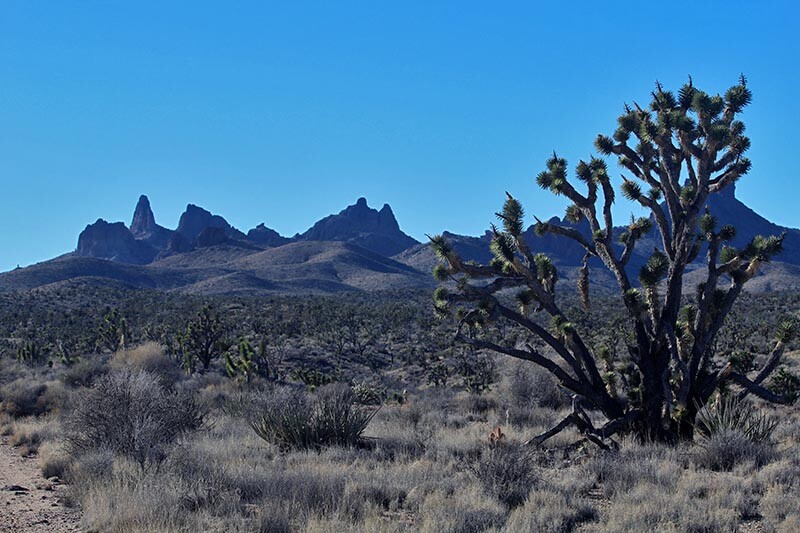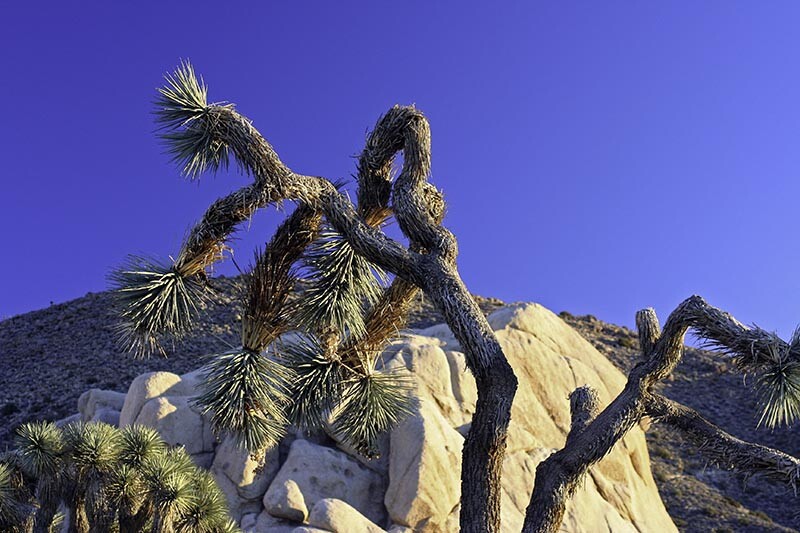4 Reasons Joshua Trees Aren't Out of the Woods Yet


Joshua trees recently took a small step closer to being protected by the federal government, but there’s a long uphill battle still facing the ungainly desert trees.
On September 14, the U.S. Fish and Wildlife Service announced that the Joshua tree, Yucca brevifolia, may merit protection as a Threatened species under the U.S. Endangered Species Act (ESA), and that the agency would begin the theoretically year-long process of examining the species’ need for protection more fully.
That finding came in response to a 2015 petition by the group WildEarth Guardians that asked USFWS to grant the Joshua tree protection. The group cited climate change, habitat loss to development, wildfires, and air pollution among the main threats to the trees’ survival.
While the September 14 announcement by USFWS was welcome news for fans of the Joshua tree, some of the reporting gave the impression that protection is close at hand for the species. While headlines along the lines of “Feds Move to Protect Joshua tree” may be literally true in the absolutely strictest sense, they can mislead casual readers into thinking the fight to protect the iconic trees has been won.
USFWS’ decision to examine listing the trees is a positive development, make no mistake. But Joshua trees are still a long way from gaining Federal protection. If that protection is granted, many Joshua trees may still be at risk of damage both from climate change and from efforts to fight climate change.
Here are four reasons that Joshua tree defenders can’t let their guard down yet.

USFWS could still say no
The WildEarth Guardians petition emphasizes climate change as the major long-term threat to the survival of the Joshua tree species, and with good reason. Joshua trees, a relic of a colder, wetter time in the southwest deserts, are already close to the edge of their heat tolerance over much of their range, and it’s unlikely they will be able to disperse their seeds to cooler parts of the desert before their present range is too hot for them.
That would seem a slam dunk reason for listing the species, but USFWS’ record on listing species put in danger by climate change is mixed. On one hand, the agency agreed in 2008 to list the polar bear as a threatened species, citing declines in the sea ice the big white bears rely on for hunting marine mammals. On the other, the same agency decided climate change wasn’t a serious threat to the American pika, an alpine relative of rabbits whose habitat is literally being pushed up mountains by warmer temperatures. In 2010, USFWS found that listing the pika wasn’t warranted. And in 2014, USFWS brass ordered an end to attempts to list the North American wolverine, even though the agency’s own scientists agreed the carnivore is critically imperiled by loss of its deep snow breeding habitat.
So there’s no clear precedent for how USFWS will decide on protecting species threatened by climate change. But even if USFWS scientists and administrators agree that climate change poses a significant enough threat to the Joshua tree that protection under the Endangered Species Act makes sense, the agency might still not do so.

Warranted but precluded
That’s because the USFWS does have a track record on delaying protection for species it agrees merit protection under the ESA. If the agency eventually finds that the Joshua tree does deserve a spot on the Threatened list, it’s very likely the tree will actually end up as one of the agency’s long list of “warranted but precluded” species, referred to by some activists as “extinction’s waiting room.” “Warranted but precluded” essentially means that USFWS agrees a species is in peril, but that other species are in worse danger and the agency doesn’t have enough bandwidth to do the paperwork on every species that deserves protection.
More than 250 species are on the “warranted but precluded” list. The Fish and Wildlife Service is supposed to review each such species annually, but a majority of those species have been on the list for at least a decade. Several dozen plant species on the “warranted but precluded” list were first proposed for listing by the Smithsonian Institution in 1975.
Given some of the species on the “warranted but precluded” list, it’s hard to imagine just how much peril a species would have to be in to not be precluded. Witness California’s Delta smelt, currently listed as Threatened, whose down-listing to Endangered was found to be warranted but precluded despite the fact that the smelt is one of the most-endangered species in the United States.
Why would USFWS find that listing the Joshua tree might be a lower priority? In part, because a large percentage of the trees’ current range is on protected land in National Parks, State parks, and designated Wilderness areas. That’s not a big help when it comes to climate change, but it does mean that Joshua trees might be deemed to be at less threat of habitat loss than species that don’t live in National Parks or wilderness areas.
Loopholes
Even if the Fish and Wildlife Service lists the Joshua tree as threatened without “precluding” it, the very habitat destruction threatening the tree might force USFWS to write compromises into the trees’ protection.
Under the Endangered Species Act, Threatened species by default get nearly the same protection as do species listed as Endangered. The main difference is that State and federal resource management agencies have a bit more leeway in working with federally Threatened species.
But there’s another tool in the Fish and Wildlife Service’s kit that it can use to manage Threatened species: the so-called 4(d) rule, named after the section of the Endangered Species Act that allows it. Under Section 4(d), USFWS can either increase or reduce protections for Threatened species, if the agency deems the changes beneficial for protecting the species.
The intent of 4(d) rules is to give USFWS — and the National Marine Fisheries Service (NMFS), the other agency that enforces ESA — flexibility to manage conflicts between protected species and people. One prominent example of a 4(d) rule, enacted in 1985, allowed state agency staff in Minnesota to trap and kill Threatened gray wolves suspected of killing livestock, an act that would have been illegal without the 4(d) rule.
The rationale behind 4(d) rules is that allowing certain kinds of harm to individuals of a Threatened species can sometimes benefit conservation of the species as a whole. In the Minnesota wolf case, USFWS’ rationale for the 4(d) rule was that angry citizens who blamed wolves for their stock losses would take matters into their own hands and kill wolves indiscriminately if they didn’t have the option of asking for help from the state.
How would a 4(d) rule be relevant to Joshua trees? As one of the biggest threats to Joshua trees’ survival is climate change, one could make the argument that hurting a few Joshua trees in order to address climate change might benefit the species as a whole. That’s not a hypothetical possibility. In the Antelope Valley, hundreds of acres of Joshua trees occupy land that solar developers have their eyes on. Several photos have made their way to social media of uprooted Joshua trees stacked in huge brush piles by construction workers clearing land for solar facilities.
Listing the Joshua tree as Threatened could mean that solar developers couldn’t treat Joshua trees that way and expect to receive any federal subsidies. And solar developers depend on federal subsidies such as tax credits for a significant percentage of their income. Any perceived risk to those subsidies could interfere with the developers’ ability to get financing for their projects.
What’s more, the U.S. Department of the Interior, USFWS’ parent agency, has for almost the last decade been engaged in aggressive promotion of desert renewable energy projects. And that suggests that a listing might well include a 4(d) rule that makes it easier for solar developers to remove Joshua trees from their projects… though they might start refraining from stacking the dying trees in unsightly piles.
As mentioned above, much remaining Joshua tree habitat is already protected in parks and wilderness areas. Development for renewable energy is one of the forms of habitat loss that most threatens the remaining areas. If 4(d) rules make it easier for developers to destroy Joshua tree habitat, that could undo much of the reason for listing the trees in the first place.

Missed deadlines
Lastly, even if the Fish and Wildlife Service decides to list the Joshua tree as Threatened with only a few minimal 4(d) rules to create exceptions to that protection, it might not happen for a while. The recent announcement that USFWS would consider the tree for protection was what’s called a “90-day finding,” so-called because the ESA requires that USFWS respond within 90 days to petitions like the one WildEarth Guardians’ filed. If you count how many days elapsed between September 28, 2015 — when WildEarth Guardians submitted its petition — and the 90-day finding’s September 14, 2016 release date, you’ll probably notice that USFWS was 242 days late in meeting that 90-day deadline.
That’s not unusual: USFWS has come under fire for years for failing to meet its legally mandated deadlines for deciding whether to list species under ESA. One study showed that the median time it took USFWS to list species from the date of petition was almost 13 years. Plant species tend to take longer to list.
According to the study, it took USFWS an average of 12 years to issue 90-day findings on flowering plant species, so the agency’s already doing well on listing the Joshua tree if you grade its performance on a curve. But there’s still the 12-month finding to get to, and half of the flowering plants under consideration for listing measured by the study took more than two years after their 90-day findings to win protection.
In other words, it could be a long time before Joshua trees win the level of protection USFWS scientists decide they require. Which means that people who want to see the Joshua tree protected shouldn’t let their guard down just yet, no matter what the headlines say.





